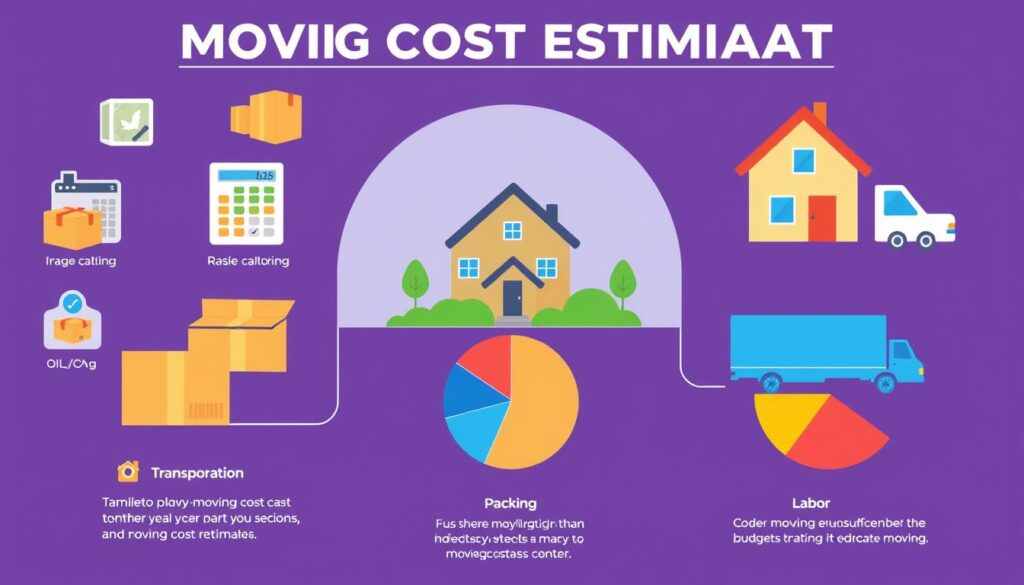What is a good moving budget?
Get Your Free Moving Estimate
A good moving budget is essential for a seamless transition to your new home. It serves as the foundation for understanding and meeting your financial expectations during your relocation. By setting a moving budget, you gain insights into both expected and unexpected costs, ultimately reducing the risk of financial stress.
Utilizing a moving expenses calculator can be particularly beneficial in estimating the total costs associated with your move. This tool allows you to input various data points, such as distance and size of your household, ensuring you have a comprehensive overview of what to expect. Additionally, researching and comparing prices can strengthen your budget and help reveal the most cost-effective options available.
In summary, a well-crafted budget not only helps you plan but ensures that you account for all anticipated expenses, paving the way for a smooth transition to your new home.
Key Takeaways
- A good moving budget reduces financial stress during the relocation process.
- Utilizing a moving expenses calculator provides clarity on potential costs.
- Researching pricing options can lead to better budgeting decisions.
- Anticipating unexpected expenses is crucial for a smooth move.
- Setting a moving budget establishes clear financial expectations.
Understanding the Importance of a Moving Budget
Creating a moving budget plays a crucial role in ensuring a smooth transition. It establishes a clear framework for managing expenses during the moving process. When we delineate costs, we can better understand what is essential versus what can wait. Utilizing a moving expenses calculator aids in breaking down these anticipated costs efficiently, allowing for greater control over finances.
Reasons to Create a Moving Budget
Several compelling reasons highlight the necessity of having a moving budget:
- Prioritization: A budget helps identify essential purchases and services, allowing us to focus on what truly matters.
- Resource Allocation: We can allocate funds effectively, reducing the risk of overspending or financial strain.
- Proactivity: A budget encourages planning ahead, which prepares us for potential challenges rather than reacting under pressure.
Benefits of Planning Ahead
Planning ahead comes with numerous benefits that contribute to a successful move:
- Stress Reduction: Having a budget minimizes uncertainties during the moving process.
- Timely Payments: We can ensure all services and expenses are managed timely, avoiding unnecessary penalties.
- Enhanced Organization: A structured budget leads to better organization and coordination during preparations.
Key Factors to Consider
Planning a move involves assessing various factors that can significantly impact our budget. Understanding these elements helps us identify cost-effective moving options and apply budget-friendly moving tips that can save money and reduce stress.
Distance of the Move
The distance of the move plays a vital role in determining overall moving costs. Local moves typically incur lower expenses due to reduced travel time and fuel costs. In contrast, long-distance relocations may require additional planning and resources, which can elevate the budget.
Size of Your Household
The size of our household is another crucial consideration. Larger families often have more belongings to transport, leading to increased costs. Assessing how much we own allows us to make informed decisions about what to take, providing a chance to downsize and cut expenses effectively.
Timing and Seasonality
When we choose to move can significantly influence the overall cost. Moving during peak seasons or weekends can lead to higher rates, as demand increases among moving companies. By planning our relocation during off-peak times, we can tap into more budget-friendly moving tips and secure better deals.
Estimating Moving Costs
Accurately estimating moving costs is essential for creating an effective moving budget. We categorize costs into two main types: fixed costs and variable costs. Understanding these distinctions enables us to manage our finances more effectively.
Fixed Costs vs. Variable Costs
Fixed costs remain consistent regardless of specific conditions associated with the move. These typically include:
- Transportation fees
- Labor costs
In contrast, variable costs can change based on various factors like distance, time of year, or specific needs. Examples include:
- Fuel expenses
- Insurance for valuable items
- Tips for movers
Typical Expenses to Include
When planning our moving costs, it’s crucial to account for all typical expenses. A thorough breakdown includes:
| Expense Category | Estimated Cost |
|---|---|
| Transportation | $300 – $1,500 |
| Packing Supplies | $50 – $200 |
| Insurance | $100 – $300 |
| Fuel Costs | $50 – $300 |
| Tips for Movers | $20 – $100 |
Utilizing a moving cost estimator allows us to pinpoint specific expenses tailored to our situation. This tool is invaluable for maintaining an affordable relocation budget, ensuring we consider every aspect of our moving journey.

Professional vs. DIY Moving
Deciding whether to hire a professional mover or undertake a DIY move can significantly impact your overall moving budget. Each option presents unique financial considerations that warrant a thorough examination.
Cost Implications of Hiring Movers
Engaging a budget-friendly moving company can alleviate many burdens. While hiring professionals typically incurs higher initial costs, several factors play a role in this decision:
- Labor Costs: Professional movers charge for their time and expertise, which often leads to a faster and safer move.
- Insurance: Many moving companies provide coverage for your belongings, which can protect against potential losses or damages.
- Efficiency: Trained teams bring skills that minimize risks associated with heavy items, reducing potential injuries.
Budgeting for a DIY Move
On the surface, a DIY move may seem more economical, yet hidden costs often arise that can increase expenses significantly. Here are some common financial considerations:
- Rental Truck Fees: Costs escalate with mileage and fuel usage, often outweighing initial savings.
- Fuel Costs: Traveling long distances can add up quickly, especially with fluctuating gas prices.
- Supplies: Purchasing boxes, packing tape, and other materials might seem minor but can add to the overall budget.
- Injury Costs: The risk of injury while moving heavy items can lead to medical expenses.
Choosing between professional movers and a DIY approach requires careful consideration of these cost implications. We recommend exploring local options that focus on reducing moving expenses while providing quality support.
Hidden Costs in Moving
When planning a move, many individuals overlook the potential hidden costs that can significantly impact their budget. It is vital to identify these expenses early on, allowing us to effectively pursue budget-friendly moving tips for reducing moving expenses.
Packing Materials and Supplies
Purchasing packing materials is often an underestimated expense. Items required for a successful packing process include:
- Boxes of various sizes
- Bubble wrap and packing paper
- Tape and scissors
- Markers for labeling
- Specialty containers for fragile or valuable items
Without proper planning, these costs can add up quickly and take a toll on our moving budget.
Unforeseen Expenses
In addition to packing supplies, unforeseen expenses can arise during the moving process. Such surprises might include:
- Additional costs for hiring extra labor to move heavy items
- Charges for last-minute storage solutions.
- Fees associated with moving during peak seasons or weekends
- Potential costs related to transportation delays or route changes
Recognizing these potential challenges prepares us to handle unexpected expenses with confidence, aligning with our goal of reducing moving expenses. By planning ahead and considering these factors, we can maintain control over our budget.
| Expense Type | Estimated Cost |
|---|---|
| Packing Materials | $200 |
| Additional Labor | $150 |
| Storage Fees | $100 |
| Transportation Delays | $75 |
By acknowledging and budgeting for both packing materials and unforeseen expenses, we can implement strategies that reinforce our commitment to budget-friendly moving tips and ensure we remain within our financial limits during this transitional period.
Creating a Moving Budget Template
Establishing a clear moving budget template is essential for managing all expenses associated with your relocation. This template acts as a roadmap, helping us allocate funds responsibly and anticipate potential costs. By outlining our budget in a structured way, we ensure that no crucial expenses are overlooked.
Essential Categories to Include
When setting a moving budget, consider breaking down your expenses into specific categories. This organization can make it easier to assess where funds are allocated. Below are the essential categories to include:
- Transportation: Costs associated with moving trucks or transport services.
- Labor: Fees for professional movers or helpers.
- Packing Supplies: Budget for boxes, tape, and packing materials.
- Miscellaneous Expenses: Include meals, lodging, and any unexpected costs.
How to Track Your Expenses
Using a moving expenses calculator can significantly simplify the tracking of our expenditures. This tool allows us to input costs as they arise, ensuring we remain aware of our spending throughout the moving process. We can choose to maintain a digital spreadsheet or utilize budgeting apps designed for tracking moving expenses. By consistently updating our tracker, we can control our financial commitments and avoid overspending as we advance towards our move.
| Category | Estimated Cost | Actual Cost |
|---|---|---|
| Transportation | $200 | |
| Labor | $500 | |
| Packing Supplies | $150 | |
| Miscellaneous | $100 |
Tips for Sticking to Your Moving Budget
Sticking to a moving budget can be challenging, but with some practical strategies, we can navigate through the process smoothly. Two essential elements come into play: setting realistic goals and utilizing technology for budgeting. By focusing on these areas, we can ensure our move remains financially sustainable.
Setting Realistic Goals
Establishing achievable objectives is crucial in maintaining our budget. We must consider our financial limitations and anticipate any emergency funds we may need. When our expectations align with our available resources, we minimize the risk of disappointment. Here are some budget-friendly moving tips to help us create realistic goals:
- Assess all potential moving expenses.
- Prioritize essential costs over optional ones.
- Allocate some budget for unexpected circumstances.
Using Technology for Budgeting
Today’s technology offers various tools that can enhance our budgeting efforts. We can leverage these tools to simplify the process and keep track of expenses effectively. A moving expenses calculator can be especially beneficial in this regard. Here are some ways technology can assist us:
- Download budgeting apps specifically designed for moving.
- Use spreadsheets to itemize expenses.
- Regularly update our progress to stay within budget.
Financial Assistance Options
Moving can present a financial challenge, but options exist to alleviate some of the burdens. Exploring financial assistance for moving can reveal grants and programs aimed at providing support, particularly for low-income families. Understanding these resources can significantly impact our affordable relocation budget and make the transition smoother.
Grants and Programs for Relocation
Various organizations offer grants aimed at assisting individuals and families with relocation expenses. These programs can be essential in providing monetary support that directly contributes to an affordable relocation budget. They often target specific demographics, including:
- Low-income families
- Disabled individuals
- Veterans
- Senior citizens
Researching local and national programs can reveal multiple avenues for securing these funds, which can cover essential moving costs like transportation and packing supplies.
Employer-Assisted Moving Expenses
Many employers recognize the financial strain associated with moving and offer assistance to their employees. This might include reimbursement for moving expenses or even direct payment to moving companies. Individuals should discuss with their HR department as employer policies can vary widely. Factors influencing this assistance can include:
- Job relocation requirements
- Company policies on moving expenses
- Length of employment
Understanding these benefits can allow us to better plan our affordable relocation budget, ensuring we leverage all available resources for a seamless move.
| Assistance Type | Description | Eligibility |
|---|---|---|
| Grants | Monetary support for eligible groups | Low-income, veterans, disabled individuals |
| Employer Reimbursement | Partial or full expense coverage for moving | Full-time employees, relocation circumstances |
| State Assistance Programs | Financial aid from state or local governments | Varies by location and income |
Updating Your Budget Post-Move
After a move, it’s crucial to revisit and update our moving budget. This allows us to assess the actual costs compared to our estimated costs. By understanding where our estimates were off, we can enhance our future moving plans. Tracking these details provides insights into our moving process, leading to better budgeting in upcoming relocations.
Assessing Actual vs. Estimated Costs
Examining actual costs helps identify areas where our moving cost estimator may have missed the mark. Analyzing discrepancies aids in understanding expenses and empowers us to refine our budget template for future moves. This exercise can pinpoint specific costs that exceeded our estimates, highlighting potential areas for improvement.
- Compare all categories of expenses.
- Note which areas had unexpected costs.
- Identify recurring expenses that can be mitigated.
Adjusting for Future Moves
Adjusting our budget based on past experiences is essential for success. Each move provides valuable lessons that can improve our budgeting practices. By reflecting on our past expenditures, we can make strategic changes aimed at reducing moving expenses in the future. Small adjustments in planning can lead to substantial savings.

| Category | Estimated Cost | Actual Cost | Difference |
|---|---|---|---|
| Packing Supplies | $200 | $250 | $50 |
| Moving Truck Rental | $500 | $450 | -$50 |
| Labor Costs | $300 | $350 | $50 |
| Utility Connection Fees | $150 | $180 | $30 |
By implementing these strategies and utilizing insights from our past moves, we can fine-tune our budget for future relocations. This commitment fosters effective planning and promotes significant reductions in overall moving expenses.
Common Budgeting Mistakes to Avoid
When planning a move, we often encounter various budgeting pitfalls that can derail our efforts. Awareness of these common mistakes enables us to stay on track and use budget-friendly moving tips effectively. A comprehensive approach ensures that we account for all required expenses and remain financially prepared.
Underestimating Costs
One of the most prevalent errors made when budgeting for a move is underestimating costs. Many people focus solely on major expenses, such as transportation and packing services, but fail to consider other necessary factors. Using a moving cost estimator can reveal potential expenses that may go unnoticed, such as:
- Fuel charges
- Tolls and parking fees
- Insurance and liability coverage
- Additional labor costs for loading and unloading
Overlooking Small Expenses
Small expenses add up quickly, potentially causing budget overruns. Often overlooked items, such as refreshments for helpers, storage supplies, and cleaning costs, can disrupt our financial plans. Keeping track of these minor costs ensures better management of our moving budget. Here are a few suggestions to help keep expenses in check:
- Compile a list of potential small expenses to anticipate
- Regularly assess how costs align with your moving budget
- Utilize budget-friendly moving tips to help manage expenses
Conclusion: Crafting Your Moving Budget
As we wrap up our discussion on what is a good moving budget, it’s essential to reflect on the key steps we’ve outlined. Regularly reviewing our budget allows us to remain vigilant throughout the moving process. By continually assessing our financial plan, we can make necessary adjustments, ensuring we stay on track and within our means. Remember, an adaptable budget is a cornerstone of a successful move.
Reviewing Your Budget Regularly
Staying proactive with our budget can help prevent unforeseen expenses from derailing our plans. By integrating budget-friendly moving tips into our routine, we maximize our chances for a seamless transition. Evaluate not only the financial aspects but also the strategies that worked effectively during your current move.
Preparing for Future Moves
Finally, as we prepare for future relocations, it is invaluable to reflect on our experiences. Consider what strategies were successful and which areas could use refinement. This reflective practice positions us to create an even more efficient moving budget next time, making our future relocations not only affordable but also stress-free. At HeavenlyMove, we are committed to empowering our community with resources and guidance for all their moving needs.


